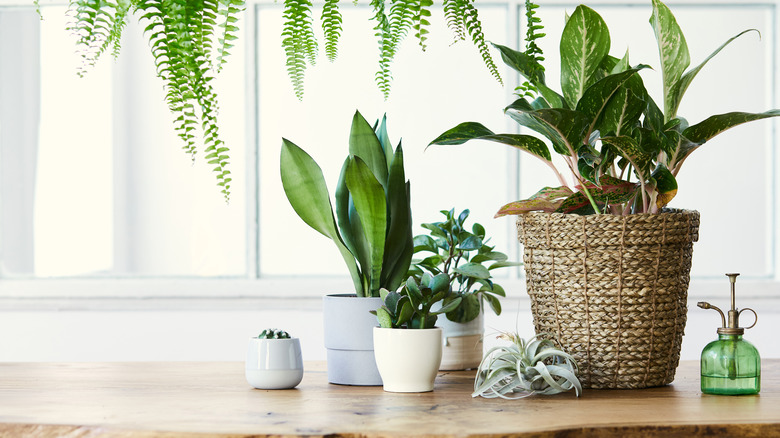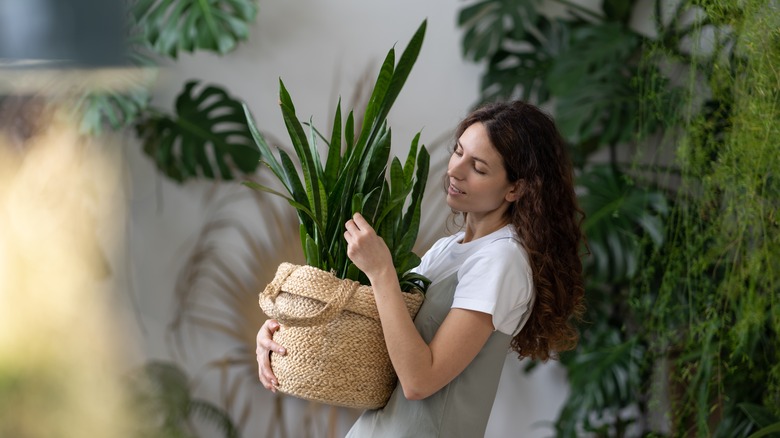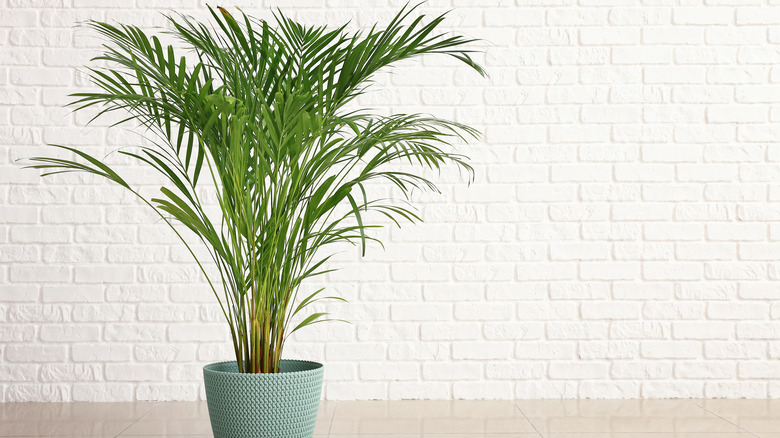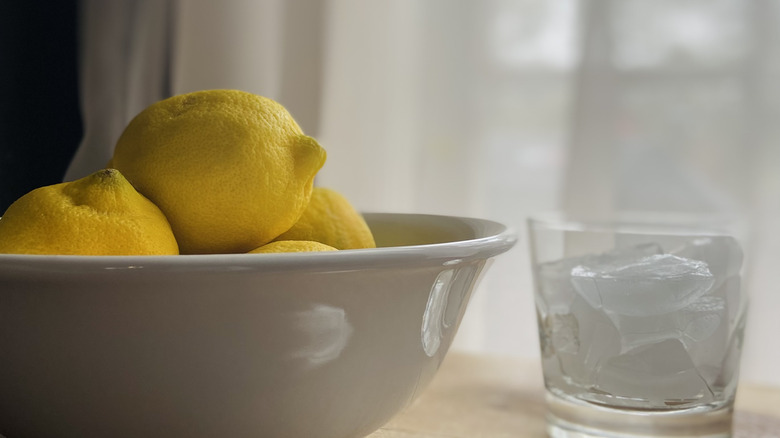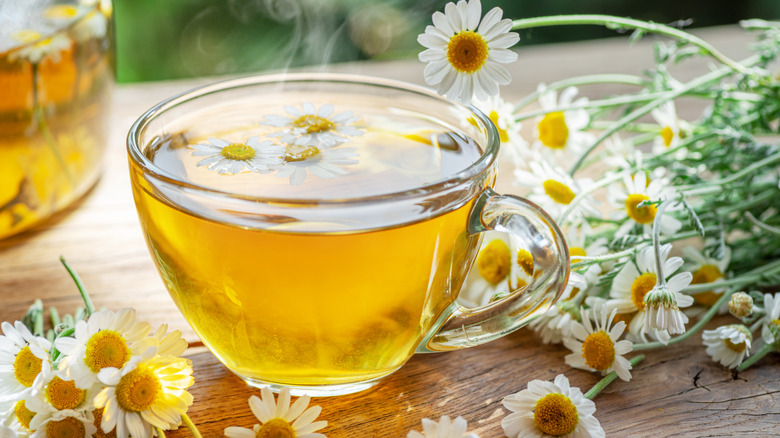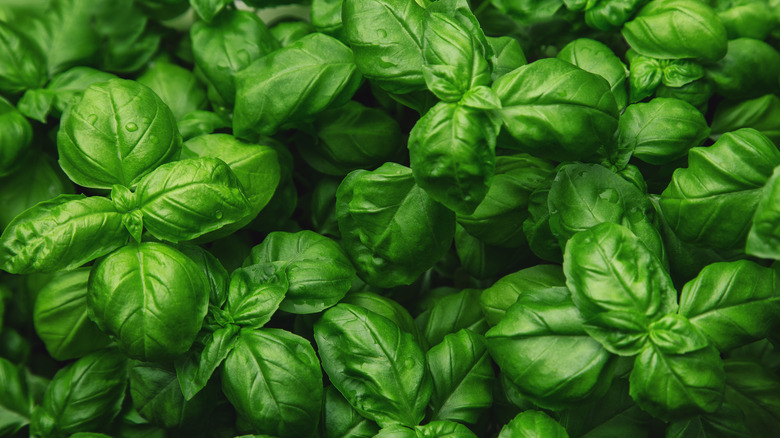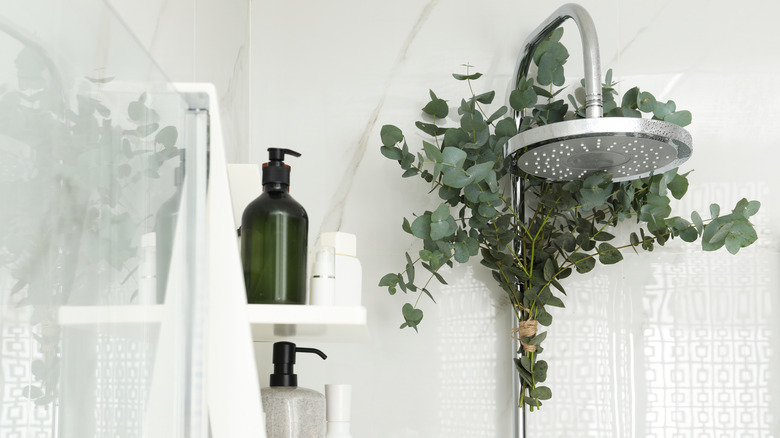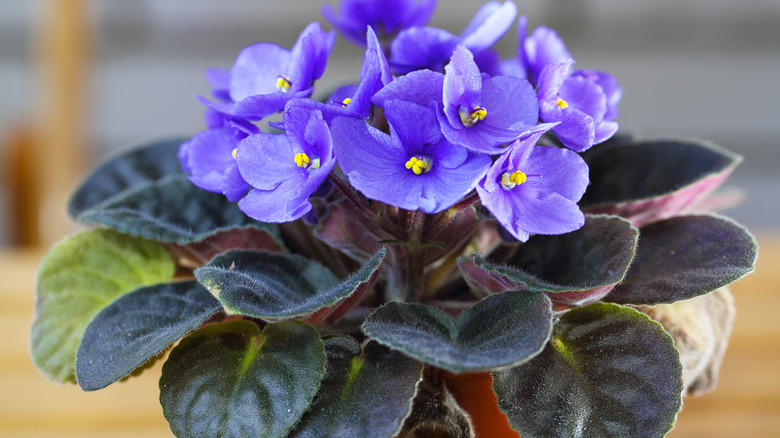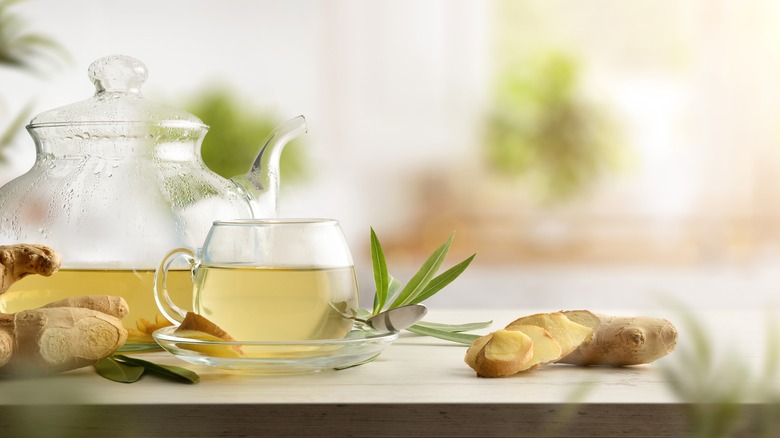How House Plants Can Be Beneficial To Your Health
Are you feeling disconnected from nature? Does your desk job or your inside nine to five keep you from frolicking in fields of wildflowers? Unless you have an outdoor career or a carefree schedule, chances are you don't spend a lot of time outdoors. According to The Nature of Americans, at least 60% of Americans over the age of 18 spend only five hours per week outdoors, and that's if the weather is permitting. That means the average person is exposed to fresh air and the calming effects of nature for less than 30 minutes per day. We all have hectic schedules and when the days get shorter, there's even less time to squeeze in quality time outdoors.
One way to combat your disconnect with nature is to incorporate house plants into your space. Fresh flowers are great, but living plants that you can care for and watch as they grow — especially ones that produce flowers or have gorgeous coloring— can be beneficial to your health in more ways than one. According to The Washington Post, just the sight of house plants and greenery can boost your mood and lift your spirits. In addition, house plants can also purify the air, reduce the stress in your life, and promote a healthy connection with nature and growth. Scientific studies that have taken place over the years and across the globe have proven that plants, and nature in general, can lift our emotional state of mind and fend off negative thoughts and feelings. During the pandemic, keeping house plants became a popular hobby that was easy to learn about and offered a reprieve for those who could not connect with nature during lockdown. If you're considering a new plant baby for your home or office, you could be doing more than just improving your decor.
Improve your home's air quality
Have you ever walked into a room that housed a lot of plants and instantly felt like you could breathe a little easier? You likely weren't imagining the fresher air or that distinct sense of liveliness. House plants are beautiful, but they are also powerful air purifiers that help filter out toxins and can allow you to breathe better. If you remember science class when you were a kid, you'll remember that plants absorb carbon monoxide, sort of like inhaling, and then they emit oxygen, which allows us to breathe freely, according to Green America. This fact has given us physical proof that we must protect the planet and the natural environment, as well as surround ourselves with plants. This bit of knowledge became important to NASA in the late '80s when they were conducting research for space travel. If there is no breathable oxygen in space, could plants help?
NASA discovered that during photosynthesis, plants can transform carbon monoxide and they can also filter other dangerous toxins that are common in your home. Toxins from fresh or old paint, off-gassing from mattresses and pillows, and other dangerous toxins around your home can be offset by a few traditional house plants that are easy to keep alive. Snake plants, also known as mother-in-law's tongue or sansevieria laurentii are great air purifiers and they do not require much maintenance. Snake plants have tall blade-like leaves that grow vertically and do need to be watered frequently. These plants can miraculously filter formaldehyde and even benzene from your home (via Gardeners' World). Another common house plant that is beautiful and can double as an air purifier is bamboo, also known as chamaedorea seifrizii. This plant may feel tropical and hard to maintain, but it actually thrives in low light and its soil only needs to stay moist.
Add moisture to the air
There's nothing as unwelcoming as harsh, dry air that makes you and your guests feel stuffy and uncomfortable when they come through the door. But did you know that extra dry air can also affect your health in a negative way? According to AQM, there are several health hazards that emerge in very dry conditions. When the air is too dry, your nasal and throat passageways can also become dried out. If the problem persists, the membranes that are meant to catch toxins, debris, and even viruses and bacteria can't function as well as they are supposed to. A little moisture in the air keeps your natural defenses against certain illnesses fighting strong. Dry air is usually a problem in the colder months because there is less fresh air and your heating system is probably cranked up. Air that is too dry can also cause nosebleeds, upset your allergies, and even make your skin feel dried out and rough. Adding a few extra plants to your office or home, especially during cooler months, can help add more moisture back into the air.
Certain house plants can offset super dry air by absorbing water and then releasing moisture back into the air through their leaves, according to Dave's Garden. One of the most well-known house plants for humidifying the air and helping with allergies is the areca palm. Through extensive research, NASA discovered that the areca palm can release approximately a quart of water back into the air in just one day. This means that they will need lots of water to survive, but fortunately, they do not require a lot of direct sunlight. Another common house plant is the spider plant. They are resilient, the lanky leaves are nice to look at, and they will also help keep your air moist.
Plants that bring a sense of peace and calm
As our schedules get busier, prices get higher, and a slew of other stressors begin to take root in our lives, you may find that you are craving just a little bit of peace. Even a small sense of calm can go a long way, and one way to achieve it is to incorporate the right plants into your home. As humans, nature is our natural state; therefore, it makes sense that we would feel more at ease when we are surrounded by greenery and growth. According to the National Library of Medicine, touching, smelling, and seeing plants can make you feel more relaxed, more grounded, and lower your blood pressure — especially in comparison to interacting with a computer and other technology. The feelings of comfort that are often related to house plants help calm the nervous system and can improve your overall mental health.
According to Floweraura, there are quite a few plants that promote a sense of calm to your body. Basil has often been associated with religion and it has natural healing abilities. The bright, vibrant green leaves and the fragrant smell can improve your sense of clarity. Lavender is frequently used for healing in its oil form, has a pleasant scent, and the muted, but beautiful, purple color is great for creating a peaceful, happy atmosphere. Peppermint or mint plants are other peaceful plants that have a beautiful scent and are easy to maintain. English ivy and chrysanthemums can also help you create an oasis in your home. If you are searching for a plant that reduces stress, it's important to choose one that is not out of your league. Go for a plant that is low maintenance and will thrive in the light you already have available.
House plants that you can grow inside and are healthy to eat
Plants have always been a form of sustenance for animals and humans. Eating certain plants can also improve your health and cure certain ailments. Although supplements are easy to find in most stores, house plants are beautiful and can do the trick as well. According to Lifehack, lemon trees are simple to grow indoors. They're vibrant and produce fruit that provides several health benefits. Dwarf trees that have been established for a few years will do the best indoors and they'll need at least eight hours of direct sunlight to thrive. Lemons, either peeled and eaten or squeezed into water, can improve your skin and hair health, reduce sore throats, and improve high blood pressure (via Organic Facts).
Dark leafy salad greens can also be grown in your home and eaten as part of a healthy diet. They contain a plethora of vitamin K, A, and C, and they're also a good source of iron. These plants can be grown from seeds with only a little bit of space, and once you harvest them, they will continue growing in a colorful, green bouquet of edible leaves. Other easy, edible plants to grow indoors are chives. These can either be started from seeds or their stems can be easily rooted and transplanted. Chives are stocked full of antioxidants and other vitamins that are great for your health when eaten. Sprinkle these over soups and salads, or make a delicious dip to incorporate these into your diet. Cilantro and parsley are commonly used and can be expensive when bought in the store; however, you can easily grow these herbs indoors from seed or seedlings in your home. Parsley contains several vitamins, which can boost your immune system. Cilantro has also been found to help fight some cancers and heart disease.
How to grow a tea garden, plus its health benefits
A tea garden can be a fun and rewarding hobby that is completely Instagramable, but it can also boost your health! Herbal teas, such as chamomile, peppermint, hibiscus, and ginger are overflowing with benefits, according to Penn Medicine. Chamomile makes for a relaxing warm beverage that can promote better sleep, while ginger and peppermint can soothe an upset stomach and settle nausea. Hibiscus doesn't just taste great — drinking hibiscus tea can also be great for liver health. Green tea, another popular beverage in many households, has an even longer list of health benefits and has become prevalent over the years. It has an important property that can help lower your cholesterol and blood pressure. In addition, this elixir can also reduce inflammation in several areas of your body, which can help with joint pain and the overall health of your skin.
Growing a tea garden can range from complicated to simple, and what you go with will depend on how committed you are. Growing the tea plant, which is known as camellia sinensis, inside can be tricky because the plant originated in Asia and needs particular conditions to grow, according to MasterClass. The tea plant, which is where green, black, white, and oolong tea comes from, needs both sun and shade and should be watered a small amount every day. On top of that, the plant must grow for two to three years before you can harvest tea. Herbal teas are typically much easier to grow in your home. Chamomile, hibiscus, and mint leaves can be harvested, dried out, and then steeped for a delicious warm treat that is a much healthier alternative to drinks with lots of sugar or artificial flavors.
House plants that deter bugs and keep your home clean
Anything that keeps bugs out of your home could be considered good for your mental health. Setting traps, spraying harmful chemicals, and the overall sense of creepy crawlies can be extremely stressful. However, certain house plants can actually deter bugs and keep your home cleaner, according to Green Care. House plants can be excellent natural mosquito repellants, which is good since mosquitos can pass along dangerous viruses such as Zika virus, West Nile virus, Chikungunya virus, dengue, and malaria that can be not only uncomfortable but also deadly (via the Centers for Disease Control). Other plants can scare away flies, spiders, and other small insects.
Many house plants that deter bugs have a very fragrant smell that will keep certain bugs at bay. Basil, for example, has a powerful smell that is pleasant to some people, but can be placed near windows and doors to avert bugs. Rosemary is another multi-purpose herb that can work as a bug repellent. However, rosemary requires drying the leaves and burning them to really get the full effect.
Carnivorous plants may sound vicious, and they are when it comes to bugs. These plants require warm, humid conditions but they will snatch up bugs faster than a bug zapper. Citronella and lemon balm also rely on their powerful yet pleasant fragrances to keep the crawlies away. Finally, catnip will make more than your furry friends happy. This plant, when it's boiled and mixed with water, can be a shockingly effective defense against mosquitoes and cockroaches. Even placing the plants or small sprigs around your home can be a deterrent that isn't toxic and won't break the bank.
Plants with multiple purposes (lavender, eucalyptus, and aloe vera)
If you are just getting started on your house plant collection, you may want to begin with a few multi-purpose plants that can benefit your health in more ways than one. According to the Cleveland Clinic, the clear jelly that is found in aloe vera leaves is often used to treat sunburn and other topical ailments. Additionally, if you scrape the jelly out, blend it with water, and drink it, the elixir can also reduce heartburn and constipation, and it can even help improve your eye health. Aloe vera is another plant that also helps purify the air, which makes it the perfect multi-purpose plant to add to your shelf.
According to the Food Network, lavender is known for its peaceful, purifying nature, but the plant can also be eaten and is a great addition to many recipes. The purple and green herb is related to mint, and it can be used for tea, or sprigs can be added to a bath for scent and relaxation. Lavender is also frequently used in desserts, such as ice creams and sorbets, because of its distinct but subtle flavor that pairs nicely with sweeter ingredients. There are also cake and pastry recipes that call for fresh lavender, as well as syrups and glazes.
When mentioning multi-purpose plants, eucalyptus cannot be overlooked. According to NetDoctor, there are a number of health benefits and they don't all need to be in the essential oil form. Eucalyptus leaves can be chewed to improve oral health. The leaves can be hung in your shower to relieve chest congestion and promote relaxation. Just the scent of eucalyptus can ease your mind and it can also repel insects.
Flowers and your emotional health
It can be difficult to find a house plant that blooms frequently or blooms at all. Yet, the emotional benefits of adding flowers to our homes are apparent and are worth the extra effort. As explained by the Society of American Florists, flowers simply make us happier. Bright colors and blossoms can trigger positive emotions and leave us feeling more fulfilled in life. Adding a few flowers can be a natural way to manage our moods and daily stresses, not only short term, but also in a lasting way.
According to Treehugger, there are house plants that have year-round blossoms or frequent blossoms that can be a pleasant surprise of color around your home. African violets are an easy house plant if you choose a pot with good drainage. They also produce simple, yet beautiful purple flowers year-round and colorful fuzzy leaves. Amaryllis bulbs can be grown in containers and they will still produce white flowers that are often marbled with other colors. Once this flower blooms, lots of water and fertilizer will keep the blossoms coming. Angel wing begonias are another flowering house plant that will draw the eye with uniquely-shaped, light pink flowers that resemble wings. Keep this plant in an area with low humidity and it will thrive if you pinch off dead and wilted flowers. Lemon trees are a beautiful addition to any home, with bright vibrant fruit and dark green leaves. The plant also produced beautiful white and yellow flowers before fruit, which is a nice addition to your decor. Just keep in mind that blossoms can also attract pets. Lemon trees, amaryllis, and angel wing begonias can be toxic to cats and dogs, so be sure to avoid those in your home or keep them out of reach if you have pets.
Other plants you can drink and eat
There are a few other plants that you can grow at home and consume for health benefits and a few of them might be unexpected. According to Treehugger, pineapple plants do appreciate warm weather but they can also be grown in a container if the temperature stays above 65 degrees. The delicious fruit is a tasty snack, but pineapple also reduces inflammation, is good for post-workout recovery, and could help with arthritis pain (via Cleveland Clinic). Microgreens are another easy plant that will bring some vibrant greens into your decor but you can also eat the nutritious leaves in salads, as a garnish, and on sandwiches. Nasturtiums produce brightly colored flowers that bloom in red, orange, cream, and yellow. The plant is beautiful and the stems, leaves, and flowers go great in a salad for a pepper-like flavor. Ginger can be grown in a deep or tall container in your home. The narrow leaves can become lush, but the root is where the health benefits are hiding. Ginger root has long been used in remedies for nausea and insomnia; however, the spicy flavor is also perfect for teas, lemonades, and desserts, and the spice goes perfectly in stir frys and other Eastern dishes.
